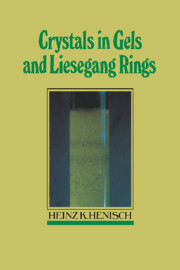5 - Liesegang Rings
Published online by Cambridge University Press: 06 January 2010
Summary
Crystal growth in gels has been a subject of intense interest for many years, but the process has remained a laboratory research activity. Certainly, it has not (or, shall we delicately say, not yet) given rise to a new industry, but it is nevertheless recognized as useful. In contrast, it would until quite recently have been necessary to admit that Liesegang Ring formation, for all its aesthetic merits, has yet to find its practical niche. One would have had to argue (as, indeed, one still does) that the study of this beautiful phenomenon is instructive in a general way, and it is its own justification. However, a new possibility has emerged which changes this position, namely that of designing anisotropic ceramics with Liesegang microstructures. This is a potentially potent technology but, of course, outside the immediate context of ‘crystal growth in gels.’
R. E. Liesegang
A tribute, first, to the discoverer who gave this set of phenomena his name. Somehow the name Liesegang has an ancient ring, and it is tempting to believe that its owner was one of the earliest chemical pioneers. In fact, Raphael Eduard Liesegang (born 1869) was as much a physicist as he was a chemist, though it was never easy to classify him into any professional niche. He lived until 1947, and did many things in his lifetime that would make a modern scientist recoil in awe. Thus, for instance, he wrote one of the earliest papers on the possibility of television (in 1891, and before the discovery of electrons), was active as a bacteriologist, contributed to chromosome theory and to the beginnings of paper chromatography, not forgetting the properties of aerosols and gelatins, the origins of silicosis, the mechanism of the photographic process in black-and-white and color (1889).
- Type
- Chapter
- Information
- Crystals in Gels and Liesegang Rings , pp. 116 - 175Publisher: Cambridge University PressPrint publication year: 1988
- 6
- Cited by



